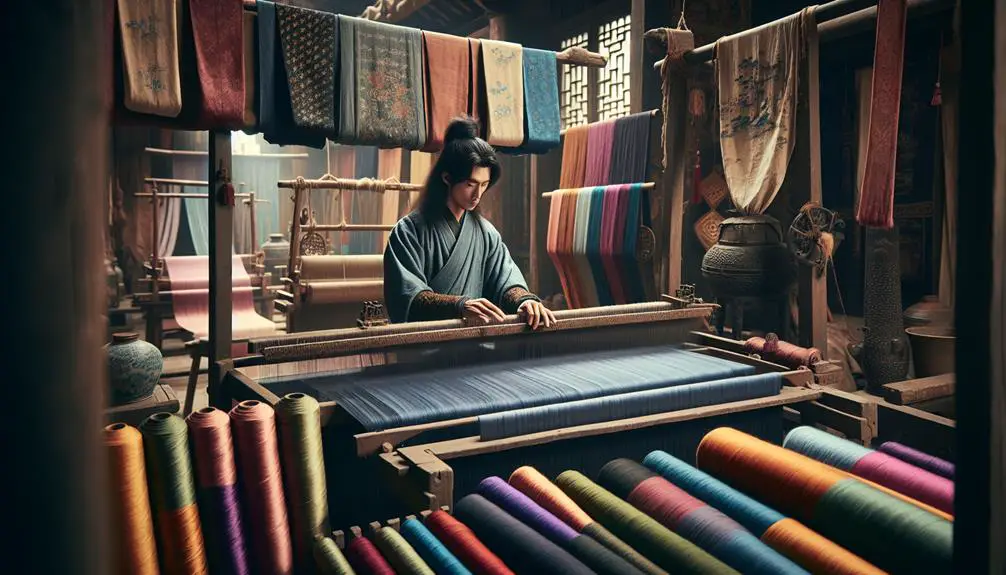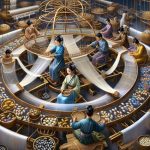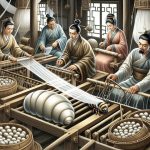I've always been fascinated by the luxurious texture of velvet and its rich history. It's intriguing how its origins are somewhat shrouded in mystery. Historically, velvet production started in China, but the exact inventor isn't well documented. This fabric quickly became a symbol of wealth and power, spreading to the Middle East and eventually Europe. Each region seemed to add its own twist to the production process, enhancing its allure and prestige. But who exactly crafted the first piece of velvet? The journey to uncover that might just change how we view this opulent material's past. What do you think led to its widespread adoption across different cultures?
Table of Contents
Key Takeaways
- Velvet originated in ancient China, where its production began.
- The specific inventor of velvet is not documented in historical records.
- Early velvet was crafted mainly from silk, using complex weaving techniques.
- The production and weaving methods were initially a closely guarded secret in China.
- Velvet spread from China to the Middle East via the Silk Road, enhancing its global presence.
Origins of Velvet
Velvet's rich history dates back to ancient civilizations where it was once a symbol of wealth and power. This luxurious fabric wasn't just any textile; it was the reserve of the elite, dripping with cultural symbolism. Kings, queens, and high-ranking officials often wore velvet, signaling their lofty status in society. The fabric's composition played a huge part in its exclusivity. Crafted from silk, and later blends including cotton or wool, velvet's intricate production process added to its allure and value.
Understanding velvet's allure isn't just about appreciating its soft, plush texture but also recognizing how it was woven into the fabric of cultural identity across various societies. In some cultures, the color of velvet garments could indicate a person's role or status. For instance, purple velvet often denoted royalty, due to the rarity and cost of the dye.
I've always found it fascinating how a single material could hold such significance. Velvet wasn't merely a fabric; it was a statement, a badge of honor, and a piece of art. Its evolution over centuries underscores its enduring appeal and the complex interplay between material culture and social stratification.
Early Production in China
While exploring velvet's ancient appeal, I discovered its early production began in China. Diving into its history, it's evident that the Silk Road origins of this luxurious fabric played a vital role. Velvet wasn't just a textile; it was a cultural transmitter, weaving together the opulence of East and West.
The technique of producing velvet in ancient China involved complex weaving systems that are impressive even by contemporary comparisons. Think of two layers of fabric being interwoven with each other, with threads meticulously cut and evenly distributed to create that plush effect. This wasn't a simple task; it required innovation and mastery, characteristics that defined Chinese artisans.
In those days, silk was a primary component, which made the velvet not only visually stunning but also incredibly soft to the touch. The production method was a guarded secret, ensuring that Chinese velvet remained a coveted item in Asia long before it touched other civilizations.
This early mastery in velvet production showcases the high level of skill and technological advancement of Chinese artisans. Today, we often marvel at new fabric technologies, but reflecting on these ancient methods offers a humbling perspective on where we've started and how far we've come in textile innovation.
Spread to the Middle East
As we look at how velvet spread to the Middle East, it's fascinating to see how quickly it was adopted there. Local artisans not only embraced but also enhanced the fabric's production techniques.
The impact of trade routes also played a vital role in velvet's journey and evolution in this region.
Early Middle Eastern Adoption
The Middle East quickly embraced velvet, incorporating it into their rich textile traditions. The Silk Road wasn't just about spices; it was a major facilitator for cultural exchange, including textiles. Velvet, with its luxurious feel and opulent sheen, found a new home in the Middle East where it was celebrated.
I've broken down its journey and impact in this handy table:
| Aspect | Detail |
|---|---|
| Introduction | Via Silk Road traders |
| Adoption | Integrated into royal and religious wear |
| Significance | Symbol of wealth and status |
Velvet's adoption here wasn't just about adding another fabric to the mix; it was a display of power, wealth, and divine connection, deeply woven into the social and cultural fabric of the Middle East.
Techniques and Artisans
When velvet reached the Middle East, skilled artisans quickly mastered and transformed its production techniques. They dove deep into artisan training, fostering a new wave of craftsmen proficient in velvet creation. Their ingenuity didn't stop there; they were pioneers in color experimentation, discovering ways to enrich velvet's hues beyond the basic.
Here's what they did to elevate velvet:
- Developed specialized looms that improved the texture and durability
- Experimented with various dyes from local plants and minerals
- Implemented rigorous training programs for aspiring artisans
- Introduced intricate embroidery techniques that further embellished velvet
- Focused on quality control to make certain each piece met high standards
This meticulous approach turned velvet into a symbol of luxury and craftsmanship in the Middle East.
Trade Routes Impact
Velvet's journey to the Middle East fundamentally transformed its status through strategic trade routes. As I explore how this luxurious fabric spread, it's evident that the Silk Road played a crucial role. This ancient network wasn't just about spices and silk; velvet, with its deep richness, traveled these paths too, reaching opulent courts and sparking a demand that only grew.
Simultaneously, maritime trade routes, less sung but equally essential, facilitated its journey across seas, connecting Venice, a key player in velvet production, to the bustling markets of Damascus and beyond. The interplay of these routes didn't just spread velvet; it wove a tapestry of cultural exchange, enhancing its value and embedding it deeply into Middle Eastern fabric, quite literally.
Techniques and Innovations
As we look at the techniques and innovations in velvet production, it's fascinating to see how historical weaving methods have laid the groundwork.
Modern technological advances have drastically changed how velvet is made, making it more accessible and versatile.
I'm excited to explore how these changes have impacted the fabric's quality and production.
Historical Weaving Methods
Exploring historical weaving methods reveals a tapestry of innovative techniques that transformed fabric production. The evolution of loom types and advancements in thread spinning were pivotal. Let's dive deeper:
- Loom types: From simple frame looms to complex treadle looms, each type brought new efficiencies and possibilities.
- Thread spinning: Innovations here drastically improved the strength and uniformity of threads, enhancing fabric quality.
- Pattern weaving: Introduction of techniques like damask and jacquard allowed for intricate designs.
- Material variety: Expansion beyond traditional wool and linen to include luxurious silks and cottons.
- Dyeing methods: Advanced dyeing techniques gave weavers a broader palette for expression.
These historical advancements set the stage for modern fabric production, shaping the materials and methods we rely on today.
Modern Technological Advances
Building on historical weaving breakthroughs, today's textile industry embraces cutting-edge technologies that revolutionize fabric production. I'm diving into how digital weaving and sustainable fibers are shaping the future of textiles. It's thrilling to see how these advancements not only enhance the quality and texture of fabrics like velvet but also promote environmental sustainability.
| Innovation | Impact |
|---|---|
| Digital Weaving | Precise patterns, reduced waste |
| Sustainable Fibers | Eco-friendly, reduces carbon footprint |
These technologies aren't just about keeping up with trends; they're about setting new standards and pushing boundaries. By integrating digital weaving, we're seeing more intricate designs and efficient production processes. And with sustainable fibers, the focus is on reducing environmental impact while maintaining the luxurious feel of fabrics. This is the future of textile production, and it's happening now!
Arrival in Medieval Europe
Velvet made its grand entry into Medieval Europe through the bustling trade routes of the Silk Road. As I investigate its fascinating journey, it's clear that its luxurious texture and rich colors quickly captivated the European nobility. You see, this isn't just about a fabric; it's about an era where velvet symbolized power, wealth, and status.
The integration of velvet into European society had profound impacts:
- Symbol of Aristocracy: Velvet became a staple in royal wardrobes, emphasizing the gap between the wealthy and the common folk.
- Gothic Influence: The fabric complemented the intricate designs of Gothic architecture, enhancing the aesthetic of grand cathedrals and noble houses.
- Adoption in Religious Ceremonies: It was extensively used in ecclesiastical vestments, adding solemnity and majesty to religious rituals.
- Gifts and Diplomacy: Velvet items were prized possessions and often used as diplomatic gifts, showcasing the wealth of the giver.
- Cultural Exchange: The fabric acted as a medium of cultural exchange, introducing Eastern techniques and styles to the Western world.
As I explore this rich history, it's clear that velvet wasn't just a fabric—it was a cultural phenomenon that left a lasting imprint on European society.
Boom in Italian Cities
As we explore the rise of velvet in Italian cities, it's evident that this fabric not only thrived but also revolutionized the local textile industry. The surge in popularity and production was no accident. It was closely tied to the fierce Italian rivalry and burgeoning maritime commerce during the Renaissance period. Cities like Venice, Florence, and Genoa weren't just picturesque, they were powerhouses of innovation and trade.
This critical spirit drove the cities to excel in textile production, and velvet, with its luxurious texture and rich appearance, was at the forefront. The fabric became a symbol of wealth and social status. The Italians weren't just making velvet; they were perfecting it, experimenting with colors and patterns that had never been seen before.
Maritime trade routes played an essential role here. These routes allowed Italian cities to import the finest raw materials from Asia and the Middle East, which were essential for high-quality velvet. Moreover, the finished velvet products found their way across Europe through these same routes, boosting the local economy significantly.
This symbiotic relationship between the textile industry and maritime commerce put Italian velvet on the map, setting standards that were revered worldwide.
Royal Patronage and Uses
Royal patronage greatly enhanced velvet's prestige, as monarchs and nobility often chose it for their opulent attire and luxurious furnishings. I've always been fascinated by how this lush fabric became a symbol of power and status. It wasn't just about looking good; velvet signified wealth, influence, and divine right in many cases.
Velvet's role in royal circles went beyond mere fashion. It was integral to courtly garments and ceremonial decor, serving as a backdrop to many historic events. Imagine the coronations, state banquets, and grand balls—all draped in the rich, deep hues of velvet. It's like the fabric itself was part of the royal family's narrative, woven into the very fabric of their reign.
Here's a quick rundown of velvet's uses in royal settings:
- Courtly Garments: Robes and gowns that defined the era's fashion.
- Ceremonial Decor: Drapes and tapestries that adorned palaces.
- Throne Upholstery: Signifying power in its plush embrace.
- Royal Portraits: Often depicted wearing velvet, enhancing regality.
- State Carriages: Lined with velvet for a touch of majesty during processions.
This fabric wasn't just a material; it was a medium that conveyed status, power, and the artistry of its time.
Evolution of Manufacturing
When I started looking into how velvet was made, I was fascinated by the early techniques used centuries ago.
It's incredible to see how modern advancements have transformed velvet production into a more efficient process.
We've come a long way from the labor-intensive methods of the past.
Early Velvet Techniques
Throughout history, early velvet manufacturing techniques evolved greatly, shifting from handcrafted methods to more mechanized processes. Initially, creating velvet was labor-intensive, focusing on achieving rich color variations and ensuring proper fabric care to maintain its luxurious texture. Here's a quick rundown:
- Hand Looms: Artisans used these to intricately weave together different types of threads.
- Dyeing Techniques: They developed methods to achieve deep and lasting colors.
- Cutting Piles: Specialized tools were crafted for precise cutting of the fabric's pile.
- Inspection Routines: Each piece was meticulously inspected for quality and consistency.
- Care Instructions: Early methods also included guidelines on how to care for velvet to preserve its elegance and texture.
Modern Production Advances
Advances in technology have revolutionized the production of velvet, making it more efficient and sustainable. Today, I'm diving into how these changes impact our beloved fabric.
Modern machines have greatly sped up the weaving process, while also cutting down on waste. Chemical treatments, essential for achieving velvet's signature softness and richness, have also seen improvements. Manufacturers now often use less harmful chemicals, aligning with more sustainable practices.
Moreover, water usage and energy consumption in velvet production have decreased thanks to new technologies. This shift not only helps the environment but also reduces costs, making velvet more accessible. It's fascinating to see how innovation continues to refine the art of velvet making, ensuring its place in both history and modern wardrobes.
Velvet in Modern Fashion
Velvet has made a big comeback in modern fashion, popping up in everything from luxurious gowns to casual streetwear. I've noticed a surge in its popularity, partly because of celebrity endorsements. When icons like Zendaya or Timothée Chalamet rock velvet on the red carpet, it definitely sparks interest. Additionally, there's a growing emphasis on sustainable sourcing. Designers are increasingly using eco-friendly practices to produce velvet, which not only appeals to environmentally conscious consumers but also adds a layer of value to the garments.
Here's how velvet is weaving its magic in today's fashion landscape:
- Runway Shows: Velvet's rich texture and sheen steal the spotlight in high fashion, making it a favorite for fall and winter collections.
- Street Style: Incorporating velvet blazers or boots adds a touch of luxe to everyday outfits.
- Accessories: Velvet bags and scarves are becoming staples for both style and comfort.
- Home Decor: From throw pillows to curtains, velvet adds a cozy, chic vibe to interiors.
- Tech Accessories: Even smartphones and laptops are sporting velvet cases, proving its versatility beyond clothing.
This revival isn't just about aesthetics; it's about making a statement with sustainability and style.
Future Trends in Velvet Use
Looking ahead, we'll likely see velvet becoming even more innovative and integrated into various industries. As we dive deeper into sustainable practices, the spotlight turns towards velvet recycling. It's not just about reusing old velvet fabrics; it's about transforming them into something new and exciting. Picture this: recycled velvet in automotive interiors or as luxurious, eco-friendly home decor. The potential is massive, and it taps into the growing demand for both luxury and sustainability.
The rise of velvet artistry is another trend I'm watching closely. Artists and designers are already pushing the boundaries of how velvet can be used, not just in fashion but in art installations and interior design. Imagine velvet sculptures or interactive velvet walls that change color with touch. The texture and sheen of velvet offer unique sensory experiences that are just beginning to be explored.
What's clear is that velvet's journey is far from over. Its rich history sets the stage for a future where its classic appeal meets modern innovation. From velvet recycling initiatives to groundbreaking art projects, we're stepping into a world where velvet isn't just seen but experienced in completely new ways.
Frequently Asked Questions
Can Velvet Be Washed or Is Dry Cleaning Necessary?
I've found that velvet cleaning methods vary. Some types can be washed, but I usually dry clean mine to be safe. It's essential for fabric care to follow the care label instructions.
Is Velvet Suitable for Summer Wear?
I wouldn't recommend velvet for summer wear due to its low breathability. It's better suited for cooler weather, so you might want to save those velvet pieces for your winter wardrobe instead.
Are There Eco-Friendly Alternatives to Traditional Velvet?
Yes, there are eco-friendly alternatives like plant-based velvet and fabrics made from recycled fibers. These options are great for reducing our environmental impact while still enjoying the luxurious feel of traditional velvet.
How Should Velvet Garments Be Stored to Prevent Damage?
To prevent damage, I store my velvet garments in a cool, dry place with proper temperature control and humidity management. It's essential to avoid cramped spaces to maintain their texture and appearance.
What Is the Difference Between Velvet and Velveteen?
Velvet's origin gives it a luxurious feel, unlike velveteen's denser texture. I've noticed velvet usually features a softer, deeper pile, while velveteen is stiffer and more durable in comparison.
- How Does Ring Spun Cotton Affect Garment Fit and Shape Retention? - August 13, 2024
- What Are the Challenges in Producing Ring Spun Cotton? - August 13, 2024
- Is Ring Spun Cotton Suitable for Plus-Size Clothing? - August 13, 2024







